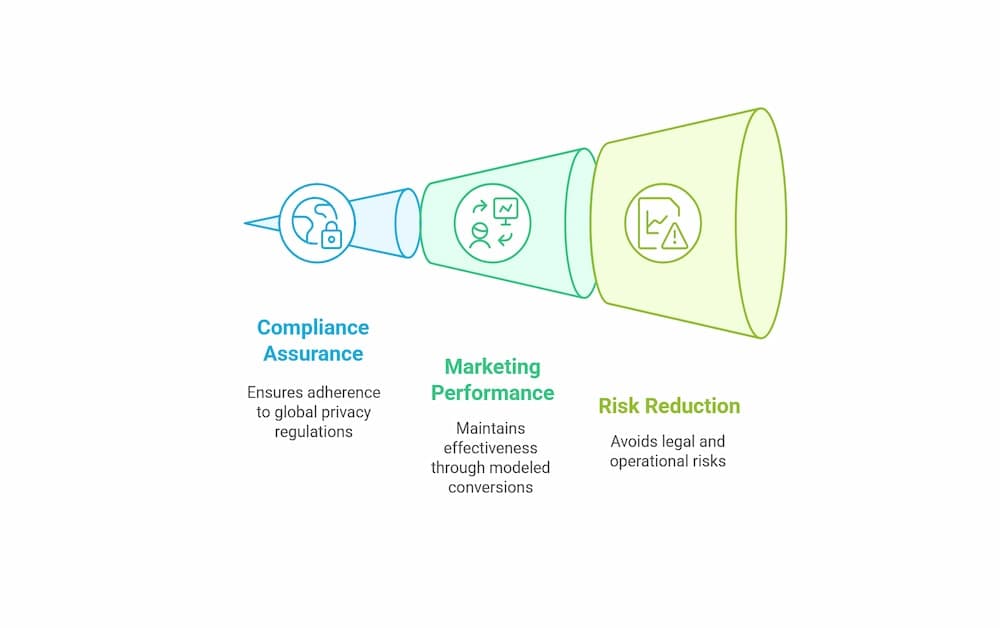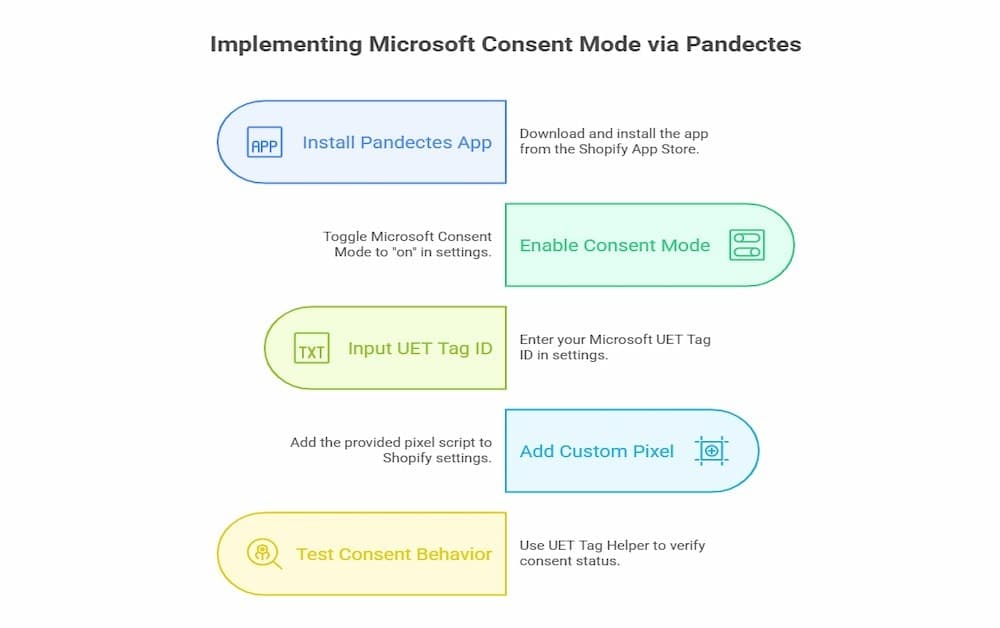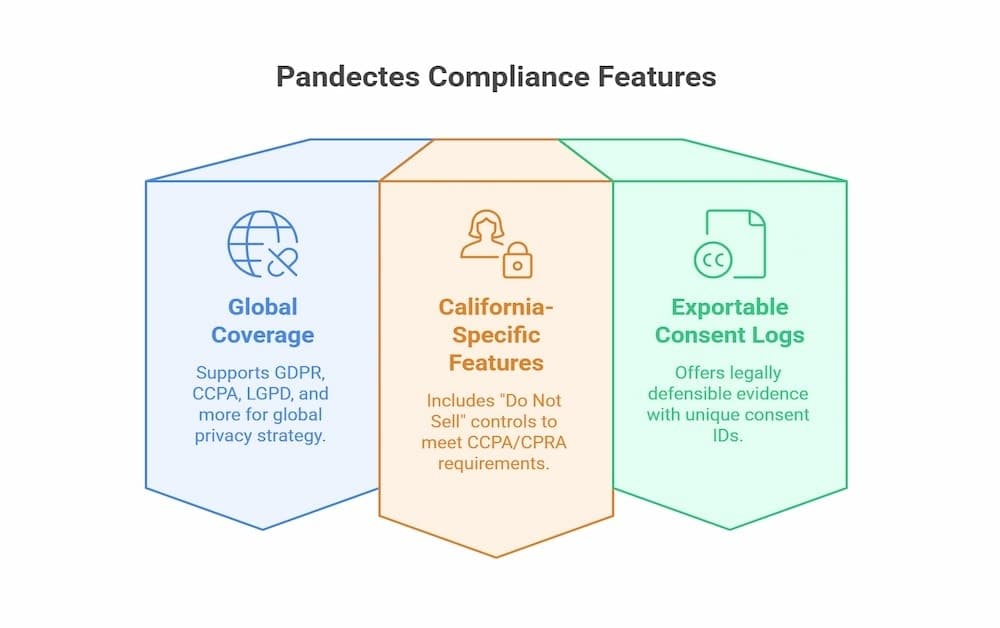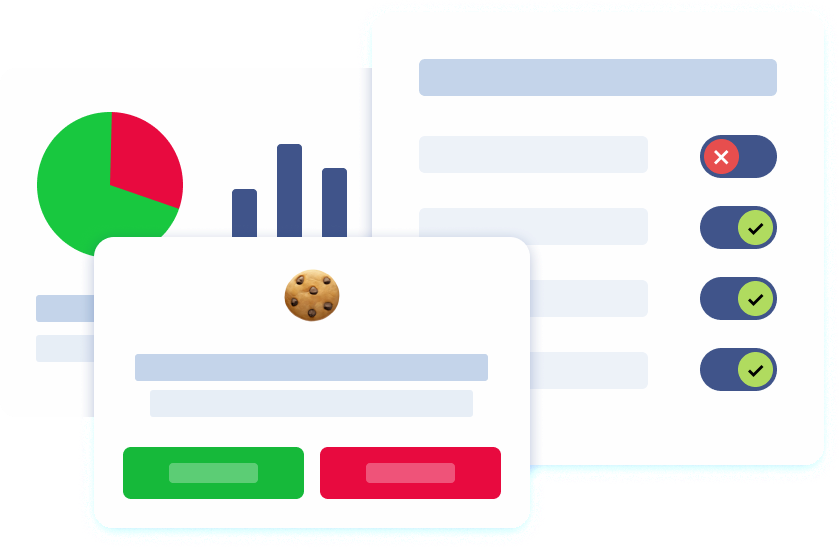Introduction
Data privacy isn’t a secondary concern; it’s a cornerstone. As digital regulations, such as the General Data Protection Regulation (GDPR) and the California Consumer Privacy Act (CCPA), continue to shape the landscape, businesses must carefully manage data collection, conversion tracking, and user privacy. Consent management platforms are essential tools that help organizations manage user consent, display consent banners, and ensure compliance with privacy laws like GDPR and CCPA by integrating with solutions such as Google Consent Mode.
Google set an early precedent with Google Consent Mode and Google Consent Mode v2, enabling users to dynamically control tags, analytics, and ads based on their consent preferences.
Now, Microsoft Consent Mode, focused on Universal Event Tracking (UET) to align with GDPR and ePrivacy Directive standards. For store owners and advertisers, Pandectes GDPR Compliance offers a streamlined, effective integration, bridging user consent, technical compliance, and marketing performance.
What Is Microsoft Consent Mode?
Launched in July 2023, Microsoft Consent Mode, also known as UET Consent Mode, allows businesses to modulate tracking based on the user’s consent status. It adjusts data collection based on whether the user has granted or denied consent, ensuring compliance with privacy laws while still enabling meaningful analytics and marketing insights. Operating similarly in concept to Google’s version, it focuses primarily on the ad_storage parameter, which switches between:
- granted: full cookie usage for ads and collecting data for analytics and marketing;
- denied: cookies are blocked, and collecting data is limited to only essential fraud-prevention signals.
How It Works
- Ads-related UET tags (or pixels) check the ad_storage value.
- When denied, tags don’t store first-party cookies, and third-party cookies are only read in a limited capacity, specifically for non-marketing purposes.
- When granted, all tracking and conversion efforts proceed normally, and UET tags are used to track user behavior and conversions.
This method ensures that user consent preferences are respected and enforced in real time, avoiding non-compliant data collection practices.
Why Is Microsoft Consent Mode Important?

1. Compliance With Global Privacy Regulations
Privacy mandates like GDPR, CCPA, and the ePrivacy Directive require explicit consent before processing personal data. Microsoft Consent Mode plays a key role in ensuring compliance with global privacy regulations by ensuring that conversion tracking, dynamic remarketing, and automated bidding only occur if explicit user consent is obtained.
Furthermore, Microsoft is also meeting the growing demands of the Digital Markets Act (DMA) by requiring advertisers to manage consent effectively and ensure proper consent signals for all tracking-related activity.
2. Maintains Marketing Performance
Non‑consented users can still contribute modeled conversions—aggregated insights that support conversion tracking, even if specific cookies are blocked. By enabling modeled conversions, Microsoft Consent Mode supports advertising strategies by allowing marketers to optimize their advertising tactics and maintain effective targeted marketing campaigns, even when full consent is not granted. This maintains marketing effectiveness while respecting user privacy.
3. Reduces Legal and Operational Risk
Microsoft has mandated the implementation of Consent Mode by May 5, 2025, for advertisers targeting users in the EEA, UK, and Switzerland. Failure to comply will result in serious consequences:
- Disabled conversion tracking and loss of vital performance metrics
- Suspended remarketing lists, crippling targeted advertising efforts
- Potential fines and legal exposure from non-compliance
By deploying Consent Mode ahead of the deadline, marketers can maintain data integrity, support smart bidding, and demonstrate adherence to global privacy laws—thereby reducing both legal and operational risks.
Pandectes: The GDPR Compliance Bridge
While Microsoft Consent Mode provides the technical framework, Pandectes GDPR Compliance app delivers the full-stack solution, especially for Shopify merchants seeking a dedicated GDPR compliance app. The Pandectes GDPR Compliance app integrates seamlessly with Microsoft Consent Mode and Google Consent Mode v2, ensuring accurate tracking and analytics while maintaining compliance. It helps manage customer data in accordance with GDPR requirements, automating deletion requests and maintaining necessary records. Pandectes also supports GDPR cookie consent through its customizable consent banner and related features, ensuring legal adherence across multiple regions. By streamlining data management, Pandectes enables store owners to achieve compliance and operational efficiency.
Certified CMP
Pandectes is both a Google‑certified CMP and a Microsoft‑certified CMP, fully integrating with the IAB Transparency & Consent Framework v2.2 (TCF)—ensuring consent signals are consistent and reliable.
Pandectes provides a customizable cookie consent banner to capture and manage user consent in compliance with GDPR and CCPA.
Turnkey Integration
- Store owners simply check a box in Pandectes settings to activate Microsoft Consent Mode.
- The app automatically populates the ad_storage parameter for UET tags based on user preferences.
- Pandectes supports checkout pages via custom pixel integration, ensuring even purchase events are consent-aware.
Google Consent Mode Support
Pandectes also seamlessly integrates Google Consent Mode v2, offering unified control over Google Analytics, Google Ads conversion tracking, and tag behavior—all governed by the same user consent data push to Google Tag Manager (GTM).
How to Implement Microsoft Consent Mode via Pandectes

Step 1: Install the App
To start, install Pandectes GDPR Compliance from the Shopify App Store. Then:
- Navigate to Settings → Integrations within the app.
- Toggle Microsoft Consent Mode—and optionally Google Consent Mode—to the “on” position.
- From that point, Pandectes will automatically send a default consent state of “denied” on every page load and then switch to “granted” once users confirm tracking.
Step 2: Add Your UET Tag ID
In the same Integrations settings:
- Input your Microsoft UET Tag ID (or multiple IDs, separated by commas).
- Pandectes automatically injects the UET tag script into each page and dynamically manages consent signals based on the user’s choice.
Step 3: Handle Checkout Events
Shopify’s checkout pages don’t allow standard app scripts to run, so Pandectes uses a custom pixel for this:
- Add the provided Pandectes pixel script via Shopify Settings → Customer Events → Add Custom Pixel.
- This pixel reads the Pandectes consent cookie and sends:
- default and update consent calls,
- purchase events containing ecomm_prodid, revenue_value, and currency, triggered only if the user consented.
- default and update consent calls,
- purchase events containing ecomm_prodid, revenue_value, and currency, triggered only if the user consented.
Step 4: Test the Behavior
To confirm everything is working correctly, use Microsoft’s UET Tag Helper in Chrome or Edge:
- Open your store in a cleaned (incognito) session.
- Enable the UET Tag Helper extension.
- Before consent:
- Refresh the page and check the Consent State (asc); it should display “denied” or show no events at all.
- Refresh the page and check the Consent State (asc); it should display “denied” or show no events at all.
- Accept the Pandectes cookie banner (or consent to marketing cookies).
- Refresh again.
- After consent:
- The Consent State (asc) should now show “granted”, indicating that UET tags are active and tracking is compliant.
- The Consent State (asc) should now show “granted”, indicating that UET tags are active and tracking is compliant.
Why This Matters
- Default denial ensures UET tracking doesn’t run until a user explicitly opts in—this is critical for GDPR, ePrivacy, and other privacy laws in the EEA.
- By triggering the update consent call once the user accepts, UET transitions to granted mode and logs conversions and events correctly.
- If consent remains denied, no tracking fires and third-party cookies are stored, providing legal protection and maintaining user trust.
Summary Table
Step | Action |
|---|---|
Install App | Enable Microsoft & Google Consent Mode → default “denied” sent on every page |
Add UET Tag ID | Input UET ID(s) → Pandectes handles script insertion and consent signals automatically |
Handle Checkout | Add custom pixel via Customer Events to manage default, update, and purchase events |
Test Setup | Use UET Tag Helper to confirm “denied” before consent and “granted” after consent |
Following these steps ensures:
- Compliant data collection under GDPR and global privacy regulations,
- Reliability: conversions are logged only with explicit consent,
- User trust: privacy-first approach that respects user choices,
- Marketing integrity: accurate conversion tracking when users opt-in,
- Legal safety: builds a strong foundation for audit readiness.
Addressing GDPR, CCPA, and Beyond

Global Privacy Regulations
Pandectes is engineered to support a truly global privacy strategy, including compliance with major privacy laws such as GDPR (EU & UK), CCPA/CPRA (California), LGPD (Brazil), VCDPA (Virginia), PDPA (Thailand), and APPI (Japan). This extensive coverage ensures Shopify store owners can confidently operate across regions with diverse regulatory demands. The platform’s built-in geolocation triggers—whether for EU, California, Brazil, Canada, or globally—help deliver tailored consent experiences according to the visitor’s location.
CCPA & Enhanced Control
Beyond GDPR, CCPA, and CPRA, Pandectes implements advanced compliance features tailored for California consumers. These include a customizable “Do Not Sell My Personal Information” link and banner options that deliver opt-in/out choices based on California privacy rules. This enhanced control reinforces transparency and aligns with GDPR-style standards for protecting user privacy both in and outside the US.
Proof of Consent
A critical component of legal compliance is storing verifiable proof of user consent. Pandectes logs every consent transaction—complete with anonymized IP, timestamp, country, consent status, and explicit preference details—into a secure backend. These records are viewable in a dashboard and can be easily exported (e.g., to CSV) for audit purposes. Each consent instance is also tied to a unique consent ID that users can reference, empowering both merchants and data subjects to verify consent details transparently.
With this setup:
- Global coverage ensures you meet GDPR, CCPA, LGPD, and more.
- California-specific features, such as Do Not Sell controls, satisfy CCPA/CPRA requirements.
- Exportable consent logs and unique consent IDs offer legally defensible evidence, reducing compliance risk.
These safeguards collectively provide a robust solution for respecting user privacy, adhering to evolving global privacy laws, and protecting your business from legal exposure.
Key Benefits at a Glance
- Compliant Data Collection: Only runs UET cookies after explicit user consent.
- Dual Platform Coverage: Supports both Google and Microsoft consent frameworks.
- Buyer Journey Protection: Tracks conversions and engagement even within GDPR constraints.
- Simplified Setup: Quick integration via Shopify interface, no manual script edits.
- Reliable Proof: Comprehensive logging for GDPR and privacy authority requests.
- Improved Data Quality: Consent-based, accurate conversion insights.
- User-Focused: Enhances transparency, strengthens trust, and improves brand reputation, which supports customer retention by fostering loyalty through privacy-compliant practices.
Compliance Workflow for Store Owners
- Set Up Banner: Choose Accept/Decline or Preferences mode in Pandectes.
- Enable Consent Mode: Select both Google and Microsoft options under Integrations.
- Insert Tag IDs: Provide UET and Google Tag Manager info.
Note: This workflow also supports integration with Facebook Pixel for compliant website tracking, conversion measurement, and analytics in line with GDPR and CCPA requirements. - Implement Checkout Pixel: Copy the Pandectes pixel script to the Shopify checkout settings.
- Validate Setup:
- Use Microsoft UET Tag Helper to track ASC values.
- Check Google Consent Mode with Tag Assistant or GA debug tools.
- Monitor & Export Logs: Access Pandectes dashboard for consent rates and export logs as needed.
Microsoft Consent Mode vs. Google Consent Mode v2
Feature | Microsoft Consent Mode | Google Consent Mode v2 |
|---|---|---|
Consent Param | ad_storage only | ad_storage, ad_personalization, etc. |
Tag Behavior | UET cookie usage based on consent | Adjusts GA, Google Ads, and Floodlight tags |
Third-Party Cookie Handling | Read-only for fraud under “denied” | Sends limited pings, adjusts tag behavior accordingly |
Integration Complexity | Single parameter setup | A multi-parameter setup can be more complex |
Aggregated Conversion Modeling | Built-in with Microsoft | Supported via Google’s modeling infrastructure |
Pandectes unifies both, enabling store owners to manage tag behavior and legal compliance seamlessly.
Future of Consent Mode
The future of Consent Mode is set to evolve alongside tightening privacy laws and rapid technological advancements. As global privacy regulations become more stringent, businesses will need to continuously adapt their consent management strategies to remain compliant. Google Consent Mode is poised to play a pivotal role in this landscape, offering a flexible framework for managing user consent and adjusting data collection practices in real time.
With ongoing integration into Google services like Google Analytics and Google Ads, Consent Mode will enable businesses to fine-tune their marketing efforts while safeguarding user privacy. As user expectations around privacy and data protection continue to rise, the ability to manage user consent effectively will become a key differentiator. By staying ahead of privacy laws and leveraging advanced consent management tools, businesses can ensure compliant data collection, maintain user trust, and drive sustainable marketing success in the digital age.
Conclusion
Microsoft Consent Mode marks a pivotal shift toward privacy‑centric ad tracking. By controlling how UET collects conversion data, user behavior, and tag interactions based on user consent, it preserves both compliance and marketing performance. Non‑compliance risks are real, data silos, broken remarketing, and policy enforcement by Microsoft are all possible consequences.
Enter Pandectes GDPR Compliance, a holistic consent framework that:
- Manages banner and cookie consent for GDPR and CCPA.
- Automatically toggles Microsoft UET and Google Consent Mode tags.
- Ensures legal compliance, customer trust, and store performance in one solution.
By adopting Pandectes, store owners can oversee user consent preferences, ensure compliant data collection, and continue to gather valuable insights, all while respecting user privacy and meeting global privacy regulations. In essence, Pandectes doesn’t just simplify consent; it transforms it into a strategic advantage.



